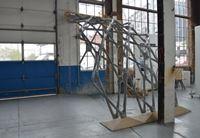Concrete Lattice: Unitized Architecture of Assembly

Concrete Lattice seeks to challenge the normative association with concrete building construction by developing a lattice system of prefabricated units using Glass-Fiber Reinforced Concrete (GFRC) as the primary material. Lattice systems are porous, lightweight, and deployable – terms that are not typically associated with concrete structures. The design of parametric units rather than linear components, typical of lattice systems, highlights issues of assembly in precast building systems using integrated components. While design workflows and CNC fabrication aided in efficiently manufacturing the units, the assembly is post-tensioned during the construction process to limit the amount of scaffolding necessary. The researchers’ goal was to address the gap between design and production by exploring the development of complex lattice systems and using digital design tools to streamline the production of units to be deployed on site.
The design of the Concrete Lattice through prototyping and fabrication highlights the value of design research for design studio learning. The complexity demonstrated through this project argues for the use of computational design in both informing design decisions and managing the myriad contingencies involved in the production of a novel structure. Complexity in this respect addresses not only formal and experiential concerns, but also structural and manufacturing processes. The Concrete Lattice makes explicit the role digital technology plays in the integration of design, engineering, and fabrication. While this discourse is not new, this design aims to take full advantage of lessons from precedents and offer a unique project uncharacteristic of what has been expected from concrete as a material.
keywords: concrete, lattice, digital fabrication, formwork design, computational design


Add comment
Log in to post comments